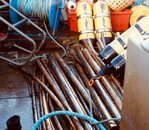Eric Sedletzky
Contributor
Northern California isn't super fine sand, at least where I dive in the far north. In our area the grains are fairly large so it sinks unless the waves are really quite large, but then we don't dive on those days because it's too hazardous. If the vis is 5 or 6 feet at shore with very mild shore break then I don't consider that to have any appreciable grit suspended in the water worth worrying about.We have the most annoying very fine grain sand by the shoreline. It gets into everything. We don't dive when there are "waves" or "surf" but it gets to be very "sandy" in the water after a storm passes. I never dove in CA waters so I can't compare. My biggest issue here is actually our supposed "fresh" water we use to rinse our equipment, it isn't that "fresh" and is salty enough that we can't drink it and have to use bottled filtered water for drinking water.
It seems based on what you describe about CA diving from shore, you do have more challenges with sand that gets into regulators first stages. My point here is that even if your conditions are worse, you still maintain your regulators and have plenty of access to service centers. We don't have any of this but our regulators, Scubapro Piston first stages, still manage to keep going despite of the neglect and abuse they get without any type of "civilized world" maintenance.
I suppose it's possible to get a few large grains of sand in the ambient chamber if you somehow got turtled in the surf let's say and dug the first stage into the sand.
But like I said, we don't dive on days like that.
There are also areas where there is very little to no sand, more gravel and rocks, so there is little to no suspended grit.
The further south you go in California the siltier it gets. Socal beaches can be pretty silty and they don't seem to worry about taking MK25's on beach dives down there.





